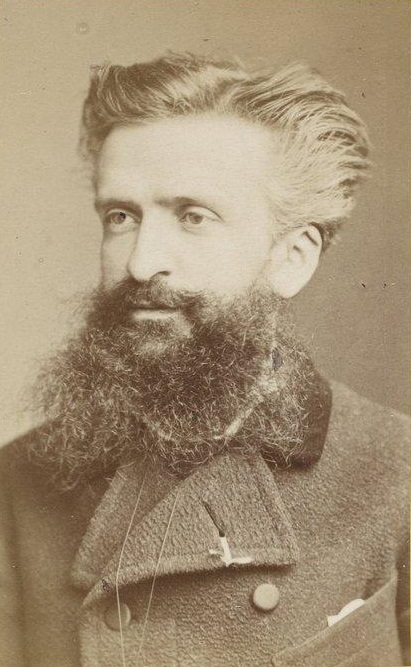
Gustave le Bon (1841-1931)
On May 7, 1841, French social psychologist, sociologist, anthropologist, inventor, and amateur physicist Gustave le Bon was born. Le Bon is best known for his study of the psychological characteristics of crowds, The Crowd, Study of Popular Mind. His writings incorporate theories of national traits, racial and male superiority, herd behavior and crowd psychology.
“Logical minds, accustomed to being convinced by a chain of somewhat close reasoning, cannot avoid having recourse to this mode of persuasion when addressing crowds, and the inability of their arguments always surprises them.”
— Gustave Le Bon, The Crowd: A Study of the Popular Mind, p. 114, Viking Press, 1960
Gustave le Bon – Early Years
Gustave le Bon was born in Nogent-le-Rotrou,Centre-Val de Loire,France. The family was of Breton origin, his father was a provincial official of the French government. In 1860 he began to study medicine at the University of Paris. He completed his practical year at the Hôtel-Dieu de Paris and obtained his doctorate in 1866, after which he called himself a doctor, although he did not work as a general practitioner. During his studies Le Bon wrote articles on a number of medical topics. His first book La mort apparente et inhumations prématurées (1866) dealt with the definition of death and anticipated the legal debates of the 20th century about it. He also managed to travel through Europe, Asia, and North Africa during the 1860s to 1880s and wrote about archaeology and anthropology.
The Franco-Prussian War
After the outbreak of the Franco-Prussian War in 1870, he joined the French army, where he worked as a military hospital doctor. During the war, Le Bon organized a division of military ambulances. In this capacity, he observed the behaviour of soldiers under conditions of total defeat and wrote about his reflections on military discipline, leadership and human behaviour in a state of stress and suffering. After the war, Le Bon was made a Knight of the Legion of Honour.
The Psychology of the Masses
Further studies on peoples, groups and masses followed between 1894 and 1903, including his major work Psychology of the Masses, which made him an influential sociologist of his time. In old age, Le Bon began to deal intensively with cataloguing humanity by establishing hierarchies for races (which he did not understand strictly biologically, but as culturally inherited complexes), genders, intelligence and political currents. Probably his first famous publication was Les Lois psychologiques de l’évolution des peuples, published in 1894.
The Crowd
Next to Gustave le Bon, also the French sociologist Gabriel Tarde, the Italian lawyer and criminologist Scipio Sighele, and the famous German sociologist Georg Simmel performed studied on crowd behavior.[7] Le Bon witnessed the Paris Commune, the rise of Georges Boulanger, and the Dreyfus Affair,[8] which each highly influenced large parts of the population. Le Bon’s concept of ‘the crowd‘ was based on the social and political developments in Paris. The city became one of the largest, most important and most industrialized cities in Europe. Right wing politics were on the rise, and especially the German conquest of Alsace and Lorraine influenced these developments.
An Individual in the Crowd
Le Bon’s model of the crowd treats it more as a unit in its composition and robs every individual member of their opinions, values and beliefs. As he says in one of his more pithy statements, “An individual in a crowd is a grain of sand amid other grains of sand, which the wind stirs up at will“. The scientist’s key processes creating a crowd are: Anonymity, Contagion and Suggestibility. Anonymity refers to an individual becoming primitive, unreasoning, and emotional. Further, according to Le Bon, it provides to rational individuals a feeling of invincibility and the loss of personal responsibility. Contagiondescribes the spread of particular behaviors in the crowd. Individuals begin to sacrifice their personal interest for the collective interest. The latter, suggestibility, refers to the mechanism to which contagion is achieved.
More on Crowd Behaviour
Other social scientists made different observations. For instance that crowd behavior is the consequence of the individuals that compose it. Floyd Allport argued that there was no actual ‘group mind’. It is believed that Edward Bernays, a nephew of Sigmund Freud was highly influenced by Gustave le Bon and Trotter.[6] Bernays published a book titled Propaganda and declared that one of the features of democracy was the manipulationof the mass by media and advertising. Gustave le Bon are known to have influenced a great variety of politicians, including Benito Mussolini and Theodore Roosevelt.
From Horses to Childhood Education
On his travels, Le Bon travelled largely on horseback and noticed that techniques used by horse breeders and trainers varied dependent on the region. In 1892, while riding a high-spirited horse, he was bucked off and narrowly escaped death. He was unsure as to what caused him to be thrown off the horse, and decided to begin a study of what he had done wrong as a rider. The result of his study was L’Équitation actuelle et ses principes. Recherches expérimentales (1892), which consisted of numerous photographs of horses in action combined with analysis by Le Bon. This work became a respected cavalry manual, and Le Bon extrapolated his studies on the behaviour of horses to develop theories on early childhood education.
Black Rays
Le Bon constructed a home laboratory in the early 1890s, and in 1896 reported observing “black light”, a new kind of radiation that he believed was distinct from, but possibly related to, X-rays and cathode rays. Not the same type of radiation as what is now known as black light, its existence was never confirmed and, similar to “N rays”, it is now generally understood to be non-existent, but the discovery claim attracted much attention among French scientists at the time, many of whom supported it and Le Bon’s general ideas on matter and radiation, and he was even nominated for the Nobel Prize in Physics in 1903. In L’Évolution de la Matière (1905), Le Bon anticipated the mass–energy equivalence, and in a 1922 letter to Albert Einstein complained about his lack of recognition.
The Psychological Crowd
Le Bon theorized that the new entity, the “psychological crowd”, which emerges from incorporating the assembled population not only forms a new body but also creates a collective “unconsciousness”. As a group of people gather together and coalesces to form a crowd, there is a
“magnetic influence given out by the crowd” that transmutes every individual’s behaviour until it becomes governed by the “group mind”. This model treats the crowd as a unit in its composition which robs every individual member of their opinions, values and beliefs; as Le Bon states: “An individual in a crowd is a grain of sand amid other grains of sand, which the wind stirs up at will“.
Gustav le Bon published his last work, entitled Bases scientifiques d’une philosophie de l’histoire, in 1931 and on 13 December, died in Marnes-la-Coquette, Île-de-France at the age of ninety
Clifford Stott, The Social Psychology of Crowds – Ideas, Identity and Impact, [10]
References and Further Reading:
- [1] Gustave le Bon Short Biography
- [2] Works by or about Gustave Le Bon at Internet Archive
- [3] Gustave le Bon’s articles at Popular Science Monthly, at Wikisource
- [4] Psychologie der Massen Article at ZEIT Online
- [5] Gustave le Bon at Wikidata
- [6] Freudian Slips and other Trifles, SciHi Blog
- [7] Georg Simmel – First Generation Sociologist, SciHi Blog
- [8] J’Accuse – Émile Zola and the Dreyfus Affaire, SciHi Blog
- [9] Les Classiques des Sciences Sociales: Le Bon
- [10] Clifford Stott, The Social Psychology of Crowds – Ideas, Identity and Impact, Keele University @ youtube
- [11] Gustave le Bon, Les Lois Psychologiques de l’Évolution des Peuples (1894); (“The Psychology of Peoples“, 1898)
- [12] Gustave le Bon, La Révolution Française et la Psychologie des Révolutions (1912); The Psychology of Revolution (1913)
- [13] Staff writer(s) (10 May 1941). “Gustave Le Bon”. Nature. 147 (3732): 573.
- [14] Widener, Alice (1979), Gustave Le Bon, the Man and His Works, Liberty Press
- [15] Timeline of Crowd Psychologists, via DBpedia and Wikidata





